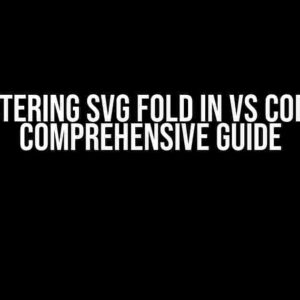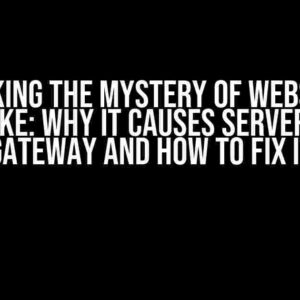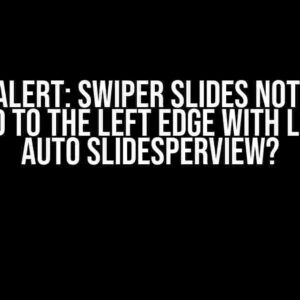Are you tired of dealing with those pesky CDATA sections in your OSB 12c projects? Do you find yourself struggling to remove them without causing errors or breaking your code? Fear not, dear developer! In this comprehensive guide, we’ll show you how to remove <![CDATA[ .... ]]> sections in OSB 12c with ease.
What is CDATA and Why Do We Need to Remove it?
CDATA (Character Data) is a section in an XML document that contains data that should not be parsed by the XML parser. It’s often used to include special characters or code snippets in XML files without causing errors. However, in OSB 12c, CDATA sections can cause issues with payload validation and transformation. That’s why it’s essential to remove them before processing your XML data.
Method 1: Using the Replace Operator
This method involves using the Replace operator in OSB 12c to remove the CDATA section. Here’s how to do it:
<xsl:template match="/">
<xsl:variable name="payload">
<xsl:value-of select="replace(., '<![CDATA[.*?]]>', '')"/>
</xsl:variable>
<xsl:value-of select="$payload"/>
</xsl:template>
In this example, we’re using the Replace operator to remove the CDATA section from the payload. The regular expression <![CDATA[.*?]]> matches the CDATA section, and the empty string replaces it.
Method 2: Using the translate() Function
This method involves using the translate() function in OSB 12c to remove the CDATA section. Here’s how to do it:
<xsl:template match="/">
<xsl:variable name="payload">
<xsl:value-of select="translate(., '<', '')"/>
<xsl:value-of select="translate($payload, ']]>', '')"/>
</xsl:variable>
<xsl:value-of select="$payload"/>
</xsl:template>
In this example, we’re using the translate() function to remove the < and ]]> characters from the payload, effectively removing the CDATA section.
Method 3: Using a Custom XSLT Function
This method involves creating a custom XSLT function to remove the CDATA section. Here’s how to do it:
<xsl:function name="remove-cdata">
<xsl:param name="payload"/>
<xsl:value-of select="replace($payload, '<![CDATA[.*?]]>', '')"/>
</xsl:function>
<xsl:template match="/">
<xsl:variable name="payload">
<xsl:value-of select="remove-cdata(.)"/>
</xsl:variable>
<xsl:value-of select="$payload"/>
</xsl:template>
In this example, we’re creating a custom XSLT function called remove-cdata that takes the payload as an input parameter and returns the payload with the CDATA section removed.
Method 4: Using a Java Callout
This method involves using a Java callout in OSB 12c to remove the CDATA section. Here’s how to do it:
<java>
public static String removeCDATA(String payload) {
return payload.replaceAll("<![CDATA[.*?]]>", "");
}
</java>
<xsl:template match="/">
<xsl:variable name="payload">
<xsl:value-of select="java:removeCDATA(.)"/>
</xsl:variable>
<xsl:value-of select="$payload"/>
</xsl:template>
In this example, we’re creating a Java callout that takes the payload as an input parameter and returns the payload with the CDATA section removed using the replaceAll method.
Best Practices for Removing CDATA Sections
Here are some best practices to keep in mind when removing CDATA sections in OSB 12c:
- Use the right method for your use case: Choose the method that best suits your requirements. If you’re dealing with simple payloads, the Replace operator or translate() function might be sufficient. For more complex payloads, a custom XSLT function or Java callout might be more suitable.
- Test thoroughly: Make sure to test your solution thoroughly to ensure that it works correctly and doesn’t break your code.
- Handle edge cases: Consider edge cases such as empty payloads or payloads with multiple CDATA sections.
- Document your solution: Document your solution clearly so that others can understand how it works and maintain it in the future.
Common Issues and Troubleshooting
Here are some common issues you might encounter when removing CDATA sections in OSB 12c:
| Issue | Troubleshooting Steps |
|---|---|
| CDATA section not removed | Check the regular expression or XSLT code for errors. Make sure the CDATA section is correctly matched. |
| Payload validation errors | Check the payload schema and validation rules. Make sure the payload is valid after removing the CDATA section. |
| Performance issues | Optimize the XSLT code or Java callout for performance. Consider using caching or parallel processing. |
By following the methods and best practices outlined in this guide, you should be able to remove CDATA sections in OSB 12c with ease. Remember to test thoroughly and handle edge cases to ensure that your solution works correctly and efficiently.
Conclusion
Removing CDATA sections in OSB 12c can be a challenge, but with the right techniques and best practices, it’s a task that can be accomplished with ease. By using the methods outlined in this guide, you’ll be able to process your XML payloads efficiently and effectively, without the hassle of CDATA sections getting in the way.
Further Reading
If you’re interested in learning more about OSB 12c and XSLT, here are some additional resources:
We hope you found this guide helpful! If you have any questions or feedback, please don’t hesitate to reach out.
Here are the 5 Questions and Answers about “How to remove in OSB 12c”:
Frequently Asked Question
Stuck with those pesky CDATA sections in your OSB 12c project? Don’t worry, we’ve got you covered! Here are the top 5 questions and answers to help you remove in OSB 12c.
What is and why do I need to remove it?
is an XML CDATA section used to escape special characters in XML. In OSB 12c, it can cause issues with payload transformation and validation. To avoid these problems, you need to remove it from your XML payload.
How do I remove from a single XML element in OSB 12c?
To remove from a single XML element, you can use the `replace()` function in an XQuery expression. For example: `replace($element,”
Can I use a regular expression to remove from multiple XML elements?
Yes, you can use a regular expression to remove from multiple XML elements. In an XQuery expression, use the `replace()` function with a regular expression, such as: `replace($payload,”\“,””)`.
What if I need to remove from the entire XML payload?
To remove from the entire XML payload, you can use an Assign activity in OSB 12c. Assign the payload to a new variable and use the `replace()` function with a regular expression, such as: `replace($payload,”\“,””)`.
Are there any limitations or potential issues when removing in OSB 12c?
Yes, be cautious when removing as it may affect the original intent of the XML payload. Additionally, removing CDATA sections can lead to XML validation issues if the payload contains special characters. Always test your implementation thoroughly to ensure the desired outcome.

![How to Remove <![CDATA[ …. ]]> in OSB 12c: A Step-by-Step Guide How to Remove <![CDATA[ …. ]]> in OSB 12c: A Step-by-Step Guide](https://belenda.hkhazo.biz.id/wp-content/uploads/sites/649/2024/07/how-to-remove-cdata-in-osb-12c-a-step-by-step-guide-with-text.jpg)



